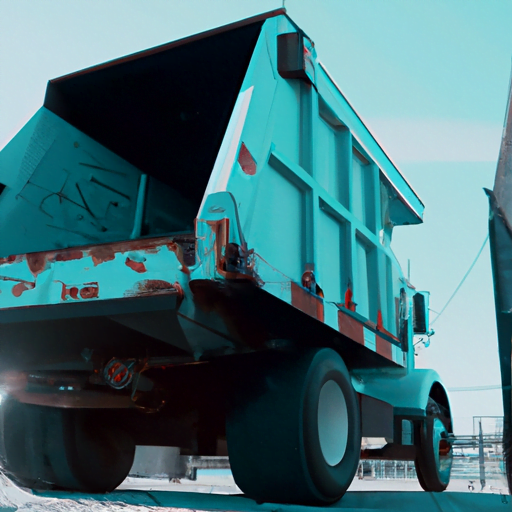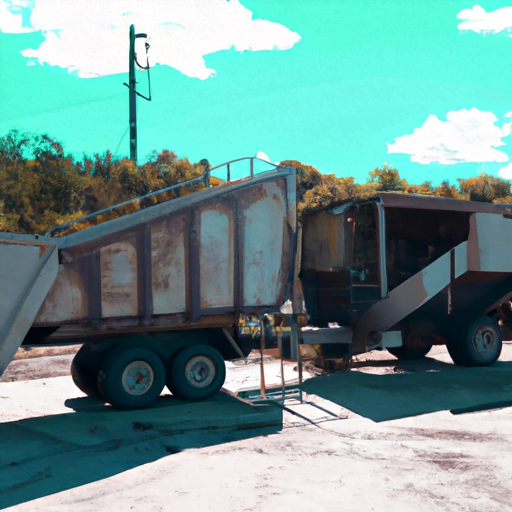-
Table of Contents
Learn about the evolution of dump trailers today! Click here to discover the past, present, and future of dump trailers.
Introduction
Dump trailers have been an essential tool in the construction and transportation industries for decades. Over time, these trailers have evolved to become more efficient, durable, and versatile. In this article, we will explore the past, present, and future of dump trailers, including their history, current features, and potential advancements.
The History of Dump Trailers: Tracing the Evolution from Past to Present
Dump trailers have been around for centuries, and they have come a long way since their inception. These trailers have been used for various purposes, including transporting goods, construction materials, and waste. The evolution of dump trailers has been a fascinating journey, and it is interesting to see how they have changed over time.
The earliest dump trailers were simple carts that were pulled by horses or oxen. These carts were used to transport goods and materials, and they were often made of wood. The carts had a simple mechanism that allowed them to be tipped over, which made it easier to unload the goods. These carts were not very efficient, and they were often difficult to maneuver.
In the early 1900s, dump trailers started to become more advanced. The first hydraulic dump trailer was invented in 1904, and it revolutionized the way goods were transported. The hydraulic system allowed the trailer to be lifted and tilted, which made it easier to unload the goods. This innovation made dump trailers more efficient and easier to use.
Over the years, dump trailers continued to evolve. In the 1920s, dump trailers started to be used in the construction industry. These trailers were used to transport construction materials, such as gravel and sand. The trailers were also used to transport waste from construction sites. Dump trailers became an essential tool in the construction industry, and they helped to make construction projects more efficient.
In the 1950s, dump trailers started to be used in the agricultural industry. Farmers used dump trailers to transport crops, such as corn and wheat. The trailers were also used to transport livestock, such as pigs and cows. Dump trailers made it easier for farmers to transport their goods, and they helped to increase productivity in the agricultural industry.
Today, dump trailers are used in a variety of industries, including construction, agriculture, and waste management. Dump trailers have become more advanced over the years, and they are now made of durable materials, such as steel and aluminum. The trailers are equipped with advanced hydraulic systems that make it easier to lift and tilt the trailer. Dump trailers are also equipped with safety features, such as brakes and lights, to ensure that they are safe to use on the road.
The future of dump trailers looks bright. As technology continues to advance, dump trailers will become even more efficient and easier to use. There are already dump trailers that are equipped with GPS systems, which allow the user to track the trailer’s location and monitor its performance. In the future, dump trailers may be equipped with even more advanced technology, such as self-driving capabilities.
In conclusion, the evolution of dump trailers has been a fascinating journey. From simple carts to advanced hydraulic systems, dump trailers have come a long way since their inception. Dump trailers have become an essential tool in various industries, and they have helped to increase productivity and efficiency. As technology continues to advance, dump trailers will continue to evolve, and they will become even more efficient and easier to use. The future of dump trailers looks bright, and we can’t wait to see what innovations will come next.
Innovations in Dump Trailers: A Look into the Future of Hauling and Dumping
Dump trailers have been around for centuries, evolving from simple carts to the advanced machines we see today. These trailers have revolutionized the way we transport and dump materials, making it easier and more efficient. In this article, we will take a look at the past, present, and future of dump trailers.
The Past
The earliest dump trailers were simple carts that were pulled by horses or oxen. These carts were used to transport materials such as dirt, rocks, and sand. The carts were designed with a simple mechanism that allowed the bed to be tilted, allowing the materials to be dumped out. These carts were slow and inefficient, but they were the only option available at the time.
As technology advanced, so did the dump trailer. In the early 1900s, dump trucks were introduced, which were essentially dump trailers mounted on a truck chassis. These trucks were faster and more efficient than the horse-drawn carts, and they quickly became the preferred method of hauling and dumping materials.
The Present
Today, dump trailers come in a variety of sizes and configurations, from small utility trailers to large semi-trailers. They are used in a wide range of industries, including construction, agriculture, and mining. Modern dump trailers are designed with advanced features such as hydraulic systems, which allow for easy dumping of materials.
One of the most significant advancements in dump trailers is the introduction of aluminum trailers. Aluminum trailers are lighter and more durable than traditional steel trailers, making them more efficient and cost-effective. They are also resistant to corrosion, which makes them ideal for use in harsh environments.
Another innovation in dump trailers is the use of GPS technology. GPS systems can be used to track the location of the trailer, monitor the speed and direction of travel, and even alert the driver if the trailer is overloaded. This technology has made it easier for companies to manage their fleets and ensure that their trailers are being used efficiently.
The Future
As technology continues to advance, so will the dump trailer. One of the most exciting developments in dump trailers is the use of autonomous technology. Autonomous dump trailers will be able to operate without a driver, using sensors and cameras to navigate and dump materials. This technology has the potential to revolutionize the way we transport and dump materials, making it safer and more efficient.
Another innovation in dump trailers is the use of electric power. Electric dump trailers will be powered by batteries, eliminating the need for diesel fuel. This technology will reduce emissions and make dump trailers more environmentally friendly.
Conclusion
Dump trailers have come a long way since their humble beginnings as simple carts. Today, they are advanced machines that are used in a wide range of industries. As technology continues to advance, we can expect to see even more innovations in dump trailers, making them safer, more efficient, and more environmentally friendly. The future of dump trailers is exciting, and we can’t wait to see what the next generation of trailers will bring.
The Future of Dump Trailers: Advancements and Trends to Watch Out For
Dump trailers have come a long way since their inception in the early 1900s. From simple, manually operated dump carts to modern hydraulic dump trailers, these vehicles have undergone significant changes over the years. As technology continues to advance, the future of dump trailers looks promising, with several advancements and trends to watch out for.
One of the most significant advancements in dump trailers is the use of hydraulic systems. Hydraulic dump trailers use pressurized fluid to lift and lower the trailer bed, making it easier and more efficient to load and unload materials. This technology has revolutionized the way dump trailers are used, making them more versatile and efficient.
Another trend to watch out for is the use of lightweight materials in dump trailer construction. Lightweight materials such as aluminum and composite materials are becoming increasingly popular due to their durability and weight-saving properties. These materials not only make the trailers lighter, but they also increase their load capacity, making them more efficient and cost-effective.
The use of automation and technology is also becoming more prevalent in dump trailer design. Automated dump trailers can be controlled remotely, making it easier for operators to load and unload materials. Additionally, sensors and cameras can be used to monitor the trailer’s load and ensure that it is distributed evenly, reducing the risk of accidents and damage to the trailer.
Another trend to watch out for is the use of renewable energy sources in dump trailer design. Solar panels can be used to power the hydraulic systems, reducing the need for fossil fuels and making the trailers more environmentally friendly. This technology is still in its early stages, but it has the potential to revolutionize the way dump trailers are powered.
In addition to these advancements, there are several other trends to watch out for in the future of dump trailers. One of these is the use of telematics, which involves the use of sensors and GPS technology to monitor the trailer’s location, speed, and other important data. This information can be used to optimize routes, reduce fuel consumption, and improve overall efficiency.
Another trend is the use of artificial intelligence (AI) in dump trailer design. AI can be used to analyze data and make predictions about the trailer’s performance, allowing operators to make informed decisions about maintenance and repairs. This technology can also be used to optimize the trailer’s load capacity and reduce the risk of accidents.
Overall, the future of dump trailers looks bright, with several advancements and trends to watch out for. From the use of hydraulic systems and lightweight materials to automation and renewable energy sources, these vehicles are becoming more efficient, versatile, and environmentally friendly. As technology continues to advance, we can expect to see even more exciting developments in the world of dump trailers.
Q&A
1. What were the earliest dump trailers like?
– The earliest dump trailers were simple carts with a tilting bed that could be manually emptied.
2. How have dump trailers evolved over time?
– Dump trailers have evolved to include hydraulic systems for easier dumping, stronger materials for increased durability, and various sizes and configurations for different hauling needs.
3. What is the future of dump trailers?
– The future of dump trailers may include advancements in technology such as remote control operation and increased automation, as well as continued improvements in efficiency and sustainability.
Conclusion
Conclusion: The evolution of dump trailers has come a long way from the early days of manual dumping to the modern hydraulic systems. The present dump trailers are more efficient, durable, and versatile than ever before. The future of dump trailers looks promising with the integration of advanced technologies such as automation, telematics, and IoT. These advancements will further enhance the safety, productivity, and profitability of dump trailer operations. Overall, the evolution of dump trailers has been driven by the need for better performance, safety, and efficiency, and it will continue to evolve to meet the changing demands of the industry.


